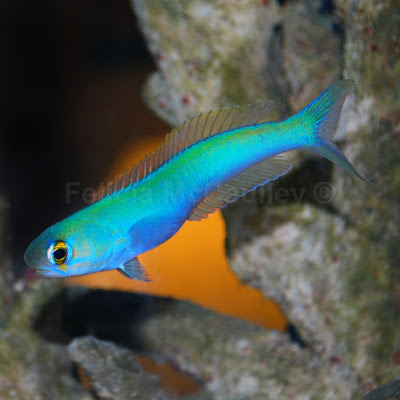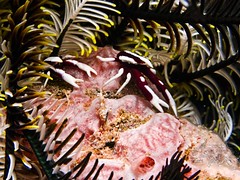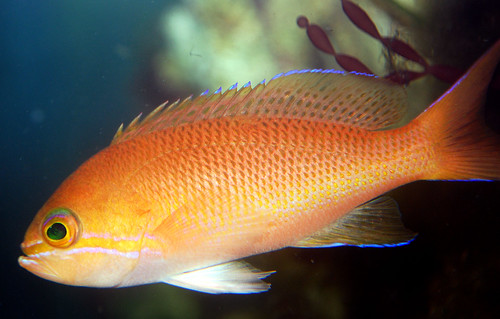
Welcome to Felicia's Aquarium Adventures, your number one source for pet Crinoid Squat Lobster information!
A couple weeks ago, I was happy to find a large white and yellow
Allogalathea elegans that I think was a female. Similar Galatheid crabs can be sexed by the width of the carapace; females have a wider carapace than the males for carrying eggs. But another close relative, the porcelain crab, the females are significantly smaller than the male. Either way, I think there is a difference in width between male and female Crinoid squat lobsters.
The photo above is a wild gravid female Crinoid squat lobster in its host. Most of the squat lobsters I see are probably juveniles or males, so I don't often see the ones with wider bodies, like the one pictured below.
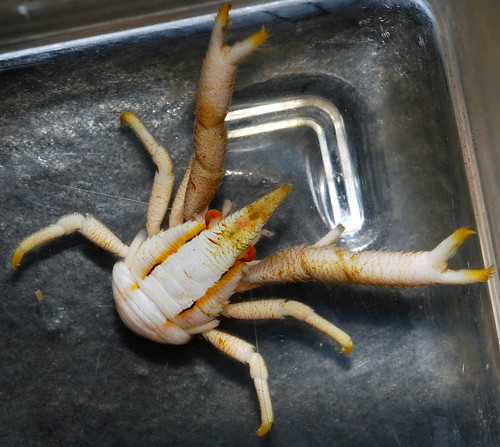
After seeing my black
Allogalathea elegans and my
Galathea inflata sharing a Crinoid, I had the idea to try to make a pair of one of my squat lobsters. I've talked to divers who say it's rare to see more than one squat lobster on a Crinoid in the wild. No one is quite sure if they live as pairs or prefer solitude. Sadly, the new squat lobster didn't live through acclimation. My dreams of having a pair of squat lobsters were dashed.
I did find another yellow squat lobster soon after, but I believe it is either a male or a juvenile. I bought him and added him to my aquarium where he started a game of musical Crinoids with the other squat lobsters.
I've never actually seen my squat lobsters battle, but I see the aftermath. There are two Crinoids in my aquarium, both are black. They've been alive, honestly, longer than I expected. One is in pretty good shape still, and it is the preferred Crinoid. The other lost the tips of its arms long ago. Darth Maul, my 2+ year old
Galathea inflata, in August was
sharing the good Crinoid with
Darth Vader, an
Allogalathea elegans who has been with us about 6 months. For a few weeks, it seemed like a truce had been struck between the two. Then one day, I woke up to find Darth Maul's molt under the good Crinoid. Darth Vader was there, but Darth Maul was missing. When I finally found him, he was in the small Crinoid and missing an arm. There must have been a feirce battle while Darth Maul was molting and Darth Vader found him in a weakened state.
Squat lobster status quo was reached and maintained until a third squat lobster, the yellow and white one my husband dubbed "Bananarama II" was added to the aquarium. This is when the game of musical Crinoids commenced. The next day, Bananarama was in the small Crinoid, Darth Maul was in the preferred Crinoid, and Darth Vader was alone. The day after that, Darth Vader took the small Crinoid from Bananarama, who I found on the complete other side of the 4 foot aquarium. Here he is next to my special-needs goby and laying claim to this empty snail shell
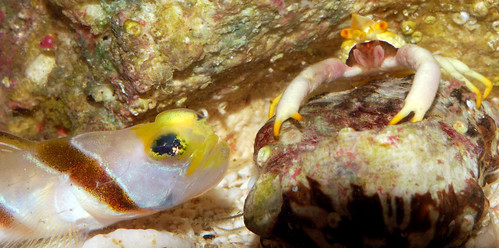
Chucks' addiction has a
beautiful gallery of hitchhiking Galatheid squat lobsters.
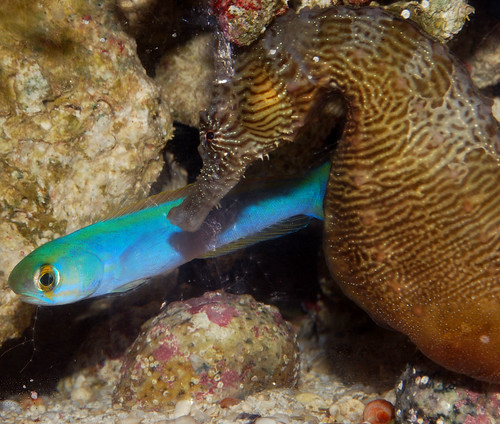 For the first two weeks, though, he hid under a rock and I had to target feed him. It didn't take him long to recognize me as the mysis dispenser, and he would come out from under his rock a few inches to eat. He's even started coming out of hiding any time I walk up to the tank, hoping to be fed. Today he was comfortable enough to swim further from his hiding place and explored the whole left side of the tank. I'm really happy he's doing so well.
As you can see, tilefish and seahorses make great companions. Above is a picture of Blinky and Juniper, my adult male H. erectus seahorse, sharing a meal together. This blue color with the green dorsal is Blinky's default coloration. When he gets excited or scared, he starts rapidly flashing all different vivid colors - pink, yellow, green purple...it's incredible. My boss had one of these for years and said that after a while, it stopped flashing and just stayed blue all the time. It's still a gorgeous fish even when it gets comfortable enough to stop flashing.
For the first two weeks, though, he hid under a rock and I had to target feed him. It didn't take him long to recognize me as the mysis dispenser, and he would come out from under his rock a few inches to eat. He's even started coming out of hiding any time I walk up to the tank, hoping to be fed. Today he was comfortable enough to swim further from his hiding place and explored the whole left side of the tank. I'm really happy he's doing so well.
As you can see, tilefish and seahorses make great companions. Above is a picture of Blinky and Juniper, my adult male H. erectus seahorse, sharing a meal together. This blue color with the green dorsal is Blinky's default coloration. When he gets excited or scared, he starts rapidly flashing all different vivid colors - pink, yellow, green purple...it's incredible. My boss had one of these for years and said that after a while, it stopped flashing and just stayed blue all the time. It's still a gorgeous fish even when it gets comfortable enough to stop flashing.
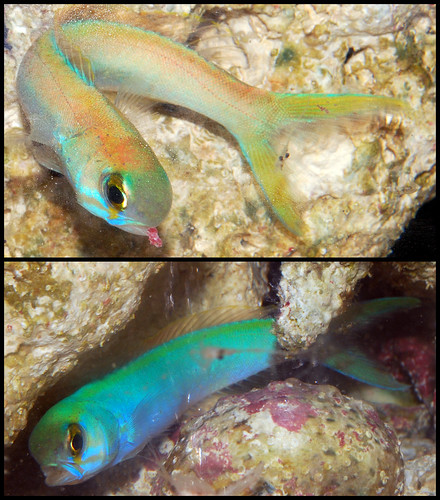 One reason tilefish are difficult to keep is because they are so shy. They should have the most peaceful tank mates like seahorses and gobies. Flashing Tilefish are especially delicate because they are deepwater fish living in waters over 100 feet deep. This is what causes their higher price tag; deepwater fish are more costly because it's more risky to dive for them. Once they are collected, they have to be slowly acclimatized to lower pressure or they will die. A Flashing Tilefish will set you back about $150 or more. But if you can find a healthy specimen, they are worth it.
Flashing Tilefish must be kept in an aquarium with a tightly closed lid. Any tiny holes in the canopy or top for tubes or cords should be well covered. The number one cause of death for Tilefish after being acclimated is from carpet surfing - jumping out of the aquarium.
December Update: Blinky is doing so great, I just love him. His favorite activity is definitely eating. He nibbles on the end of the feeding syringe or my fingers when I feed. He has no fear now and swims around all the time. He has filled out really nicely and has a fat belly.
Check out these Youtube videos of Flashing Tilefish changing colors:
One reason tilefish are difficult to keep is because they are so shy. They should have the most peaceful tank mates like seahorses and gobies. Flashing Tilefish are especially delicate because they are deepwater fish living in waters over 100 feet deep. This is what causes their higher price tag; deepwater fish are more costly because it's more risky to dive for them. Once they are collected, they have to be slowly acclimatized to lower pressure or they will die. A Flashing Tilefish will set you back about $150 or more. But if you can find a healthy specimen, they are worth it.
Flashing Tilefish must be kept in an aquarium with a tightly closed lid. Any tiny holes in the canopy or top for tubes or cords should be well covered. The number one cause of death for Tilefish after being acclimated is from carpet surfing - jumping out of the aquarium.
December Update: Blinky is doing so great, I just love him. His favorite activity is definitely eating. He nibbles on the end of the feeding syringe or my fingers when I feed. He has no fear now and swims around all the time. He has filled out really nicely and has a fat belly.
Check out these Youtube videos of Flashing Tilefish changing colors:

